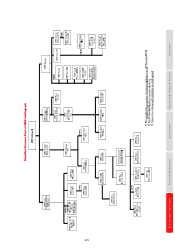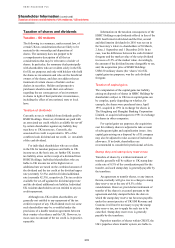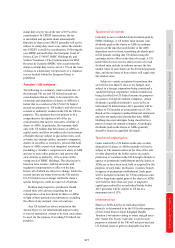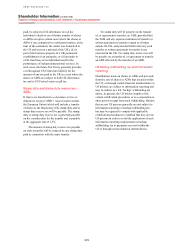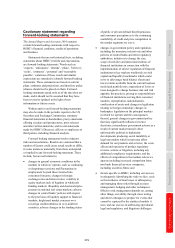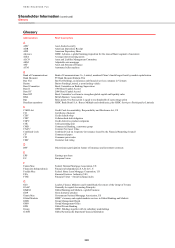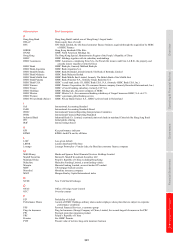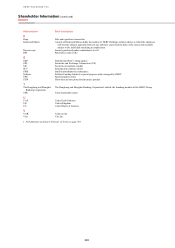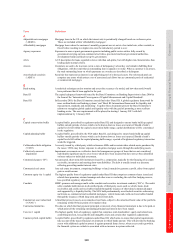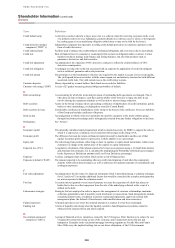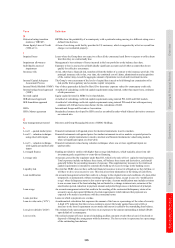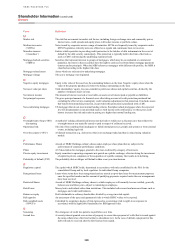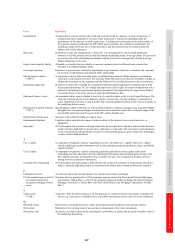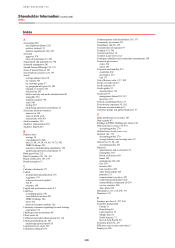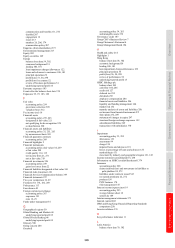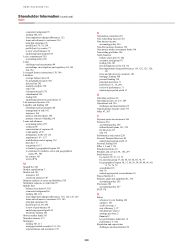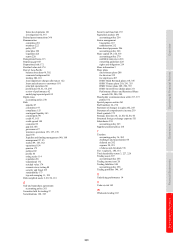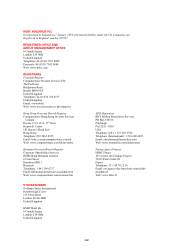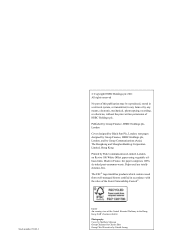HSBC 2010 Annual Report Download - page 386
Download and view the complete annual report
Please find page 386 of the 2010 HSBC annual report below. You can navigate through the pages in the report by either clicking on the pages listed below, or by using the keyword search tool below to find specific information within the annual report.
HSBC HOLDINGS PLC
Shareholder Information (continued)
Glossary
384
Term Definition
Credit default swap A derivative contract whereby a buyer pays a fee to a seller in return for receiving a payment in the event
of a defined credit event (e.g. bankruptcy, payment default on a reference asset or assets, or downgrades
by a rating agency) on an underlying obligation (which may or may not be held by the buyer).
Credit derivative product
companies (‘CDPC’s)
Independent companies that specialise in selling credit default protection on corporate exposures in the
form of credit derivatives.
Credit enhancements Facilities used to enhance the creditworthiness of financial obligations and cover losses due to asset default.
Credit risk Risk of financial loss if a customer or counterparty fails to meet an obligation under a contract. It arises
mainly from direct lending, trade finance and leasing business, but also from products such as
guarantees, derivatives and debt securities.
Credit risk adjustment An adjustment to the valuation of OTC derivative contracts to reflect the creditworthiness of OTC
derivative counterparties.
Credit risk mitigation A technique to reduce the credit risk associated with an exposure by application of credit risk mitigants
such as collateral, guarantee and credit protection.
Credit risk spread The premium over the benchmark or risk-free rate required by the market to accept a lower credit quality.
The yield spread between securities with the same coupon rate and maturity structure but with different
associated credit risks. The yield spread rises as the credit rating worsens.
Customer deposits Money deposited by account holders. Such funds are recorded as liabilities.
Customer risk rating (‘CRR’) A scale of 23 grades measuring internal obligor probability of default.
D
Debt restructuring A restructuring by which the terms and provisions of outstanding debt agreements are changed. This is
often done in order to improve cash flow and the ability of the borrower to repay the debt. It can
involve altering the repayment schedule as well as debt or interest charge reduction.
Debt securities Assets on the Group’s balance sheet representing certificates of indebtedness of credit institutions, public
bodies or other undertakings, excluding those issued by Central Banks.
Debt securities in issue Transferable certificates of indebtedness of the Group to the bearer of the certificates. These are liabilities
of the Group and include certificates of deposits.
Deed-in-lieu An arrangement in which a borrower surrenders the deed for a property to the lender without going
through foreclosure proceedings and is subsequently released from any further obligations on the loan.
Delinquency See ‘Arrears’.
E
Economic capital The internally calculated capital requirement which is deemed necessary by HSBC to support the risks to
which it is exposed at a confidence level consistent with a target credit rating of AA.
Economic profit The difference between the return on financial capital invested by shareholders and the cost of that
capital. Economic profit may be expressed as a whole number or as a percentage.
Equity risk The risk arising from positions, either long or short, in equities or equity-based instruments, which create
exposure to a change in the market price of the equities or equity instruments.
Expected loss (‘EL’) A regulatory calculation of the amount expected to be lost on an exposure using a 12 month time horizon
and downturn loss estimates. EL is calculated by multiplying the Probability of Default (a percentage)
by the Exposure at Default (an amount) and Loss Given Default (a percentage).
Exposure A claim, contingent claim or position which carries a risk of financial loss.
Exposure at default (‘EAD’) The amount expected to be outstanding after any credit risk mitigation, if and when the counterparty
defaults. EAD reflects drawn balances as well as allowance for undrawn amounts of commitments and
contingent exposures.
F
Fair value adjustment An adjustment to the fair value of a financial instrument which is determined using a valuation technique
(level 2 and level 3) to include additional factors that would be considered by a market participant that
are not incorporated within the valuation model.
First lien A security interest granted over an item of property to secure the repayment of a debt that places its
holder first in line to collect repayment from the sale of the underlying collateral in the event of a
default on the debt.
Forbearance strategies Strategies that are employed in order to improve the management of customer relationships, maximise
collection opportunities and, if possible, avoid foreclosure or repossession. Such arrangements include
extended payment terms, a reduction in interest or principal repayments, approved external debt
management plans, the deferral of foreclosures, other modifications and loan restructures.
Funded exposures A funded exposure is one where the notional amount of a contract is or has been exchanged.
Funding risk A form of liquidity risk arising when the liquidity needed to fund illiquid asset positions cannot be
obtained at the expected terms and when required.
G
Government-sponsored
enterprises (‘GSE’s)
A group of financial services enterprises created by the US Congress. Their function is to reduce the cost
of capital for certain borrowing sectors of the economy, and to make them more efficient and
transparent. Examples in the residential mortgage borrowing segment are Freddie Mac and Fannie
Mae. GSEs carry the implicit backing, but are not direct obligations, of the US Government.



